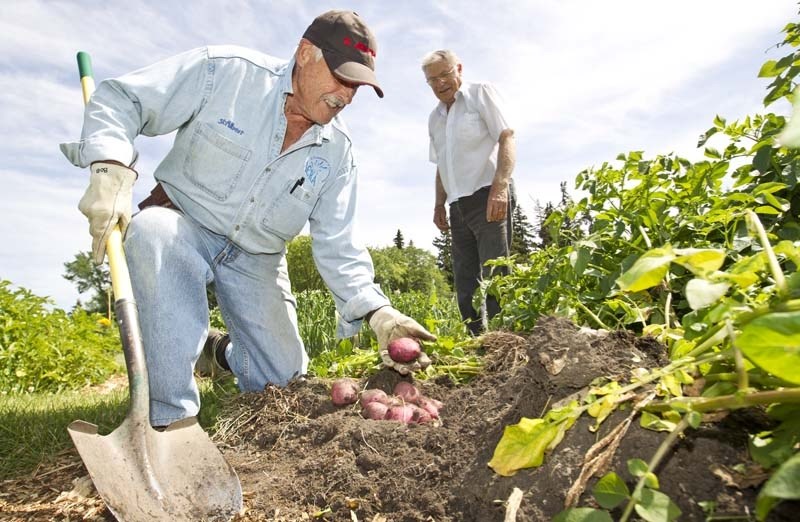Mission Hill's deep soil has helped community gardeners produce a bumper crop of vegetables this year.
"The soil is beautiful and we've had people tell us it's the best soil in St. Albert. The reason is the Oblates had their pasture and farm here behind the church," says Doris Andressen.
Andressen doesn't grow anything in the garden but she enjoys the fruits of her labour in other ways. She and fellow St. Albert Parish members Judy Victoor and Geneva Lander got the planning and development for St. Albert Heritage Garden underway in 2011 as part of the church's 150th anniversary celebrations.
"I don't have a garden plot. There is a lot of behind-the-scenes work that needs to be done," Andressen says as she walks among the 60 plots and surveys the bountiful produce.
Most of the plots are 20 feet by 20 feet and surprisingly, that's enough space to grow plenty of vegetables for a family, and then some. Vegetables are planted closely together with very little space allotted for rows, so in many cases the ferny carrot tops are right beside the leafy spinach.
"I grow this for my husband and my four children," says Louise Evanson as she picks the season's first bunch of Swiss chard.
Only organic gardening is allowed here. Initially the lawn was stripped from the site and put into a heap for compost. That composted grass is the only soil amendment that most of the gardeners use.
"When you have a garden the plants take nutrients from the soil and those nutrients have to be replenished. That grass was composted and now after three years it's beautiful soil again and it's being used to amend the soil," Andressen says.
No chemicals are allowed, even when pests are found, and the gardeners are using age-old fallowing methods and vigilance to keep them at bay. The potato blight and potato beetles, which plagued the garden in 2011, aren't a problem this summer.
No potatoes or tomatoes were allowed last year, but gardeners did plant them this spring. So far the blight is not in evidence and the gardeners are hand-picking potato beetles off the plants whenever they see them.
"Look at these potatoes. There's enough here to take with me when I go visit my sister-in-law," says Bob Russell, who has his own plot, but also mentors other on- site gardeners.
"There's very little waste, if any here," he says. "You get to know what to grow for your own family. And everybody shares."
One plot is reserved for volunteers, who grow food for the food bank.
A second plot is maintained by members of the Lo-Se-Ca Foundation, an agency that advocates for people with disabilities. At least twice a week several Lo-Se-Ca clients go to the garden to tend their vegetables, and as their support worker Pie Buzubona says, everyone is learning and profiting from the experience.
"I'm from Burundi and I'm learning lots because I never had a garden before. They take some vegetables home but we also use fresh vegetables that we grow here in our cooking classes," Buzubona says.
Compact growing
Joyce Kidney, who was supporting tall sugar-snap peas against a fence, says she has only had to change her growing habits slightly, to produce almost as many vegetables in this small plot as she used to grow in a space twice as big.
"I used to have a garden on an acreage that was the size of two plots. At first I was worried I wouldn't have enough space here. But I can grow almost as many vegetables here. I just choose to grow different, more compact vegetables like leeks, kale, beets and peas," she says.
Andressen says it's not just the gardeners who benefit from this acre of gardens, but also area residents, especially seniors, who walk through it each day. She herself has found joy and peace in this garden, even though she grows nothing herself.
"I see seniors walking, hands behind their backs, looking at each plant. I know families come with seniors from Youville Home and walk with them, in wheelchairs, to enjoy the garden. I believe this garden is helping to bring people to the land. To experience a little seed in the ground, and watching it grow and to be a part of it, is to be connected to nature."




